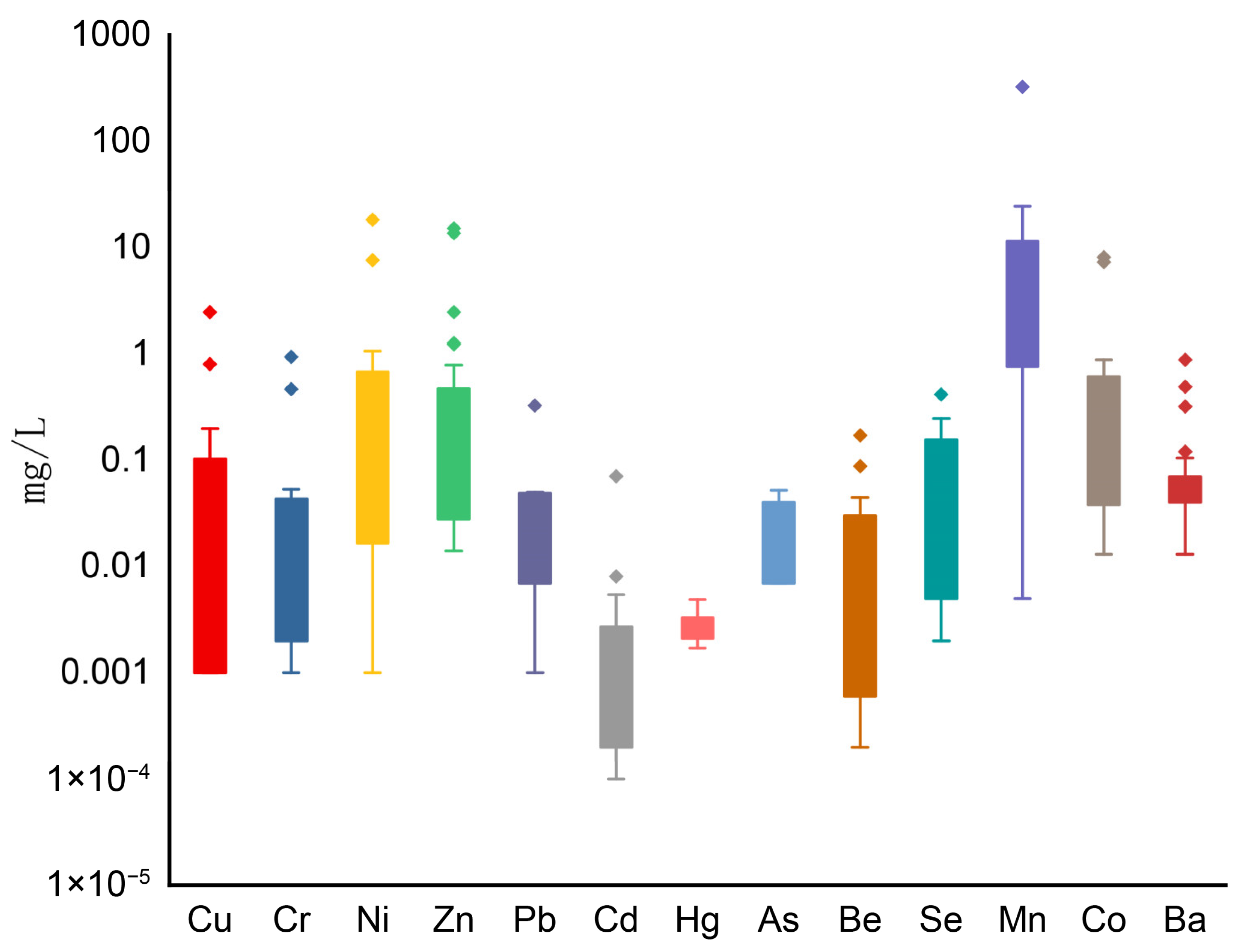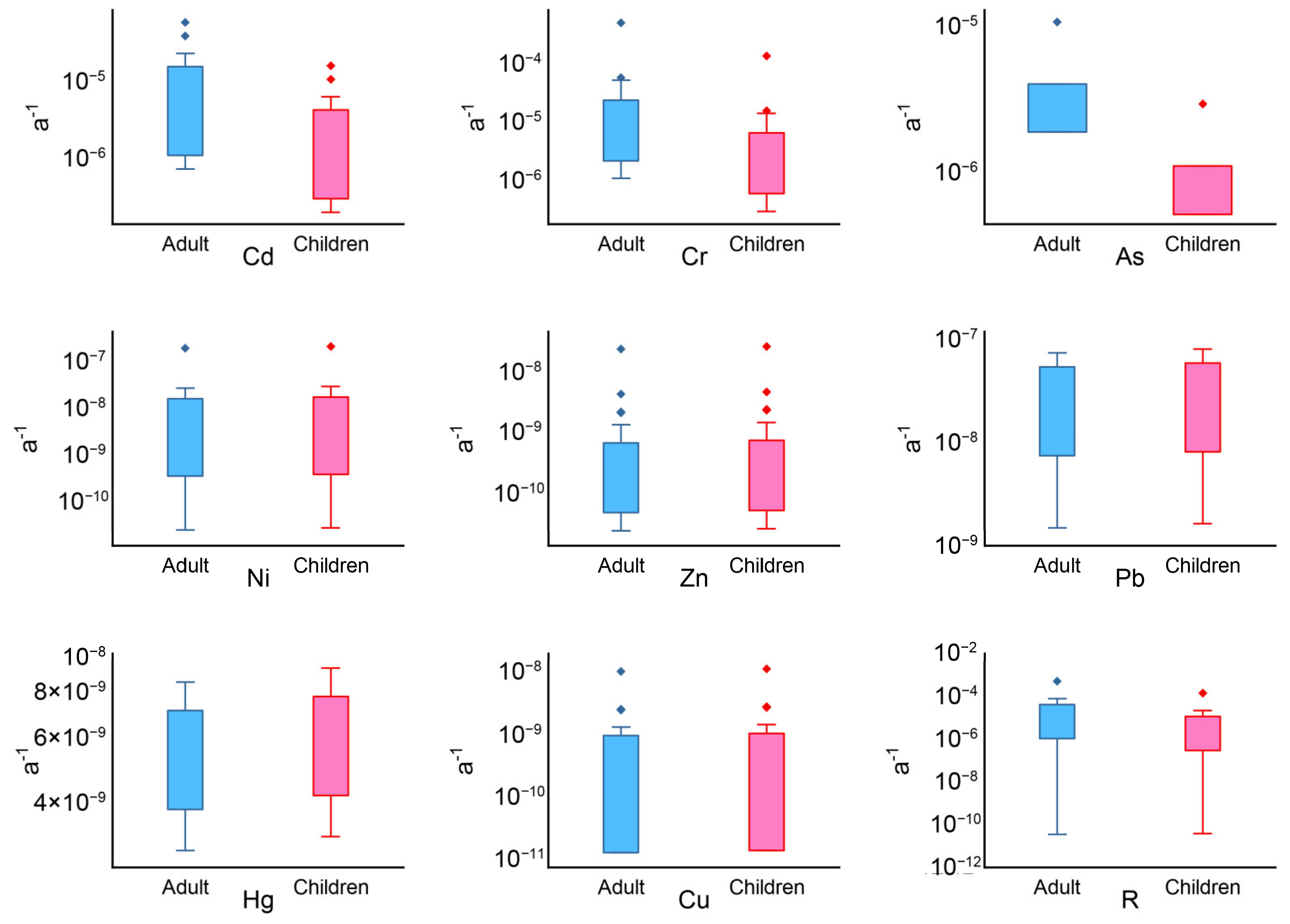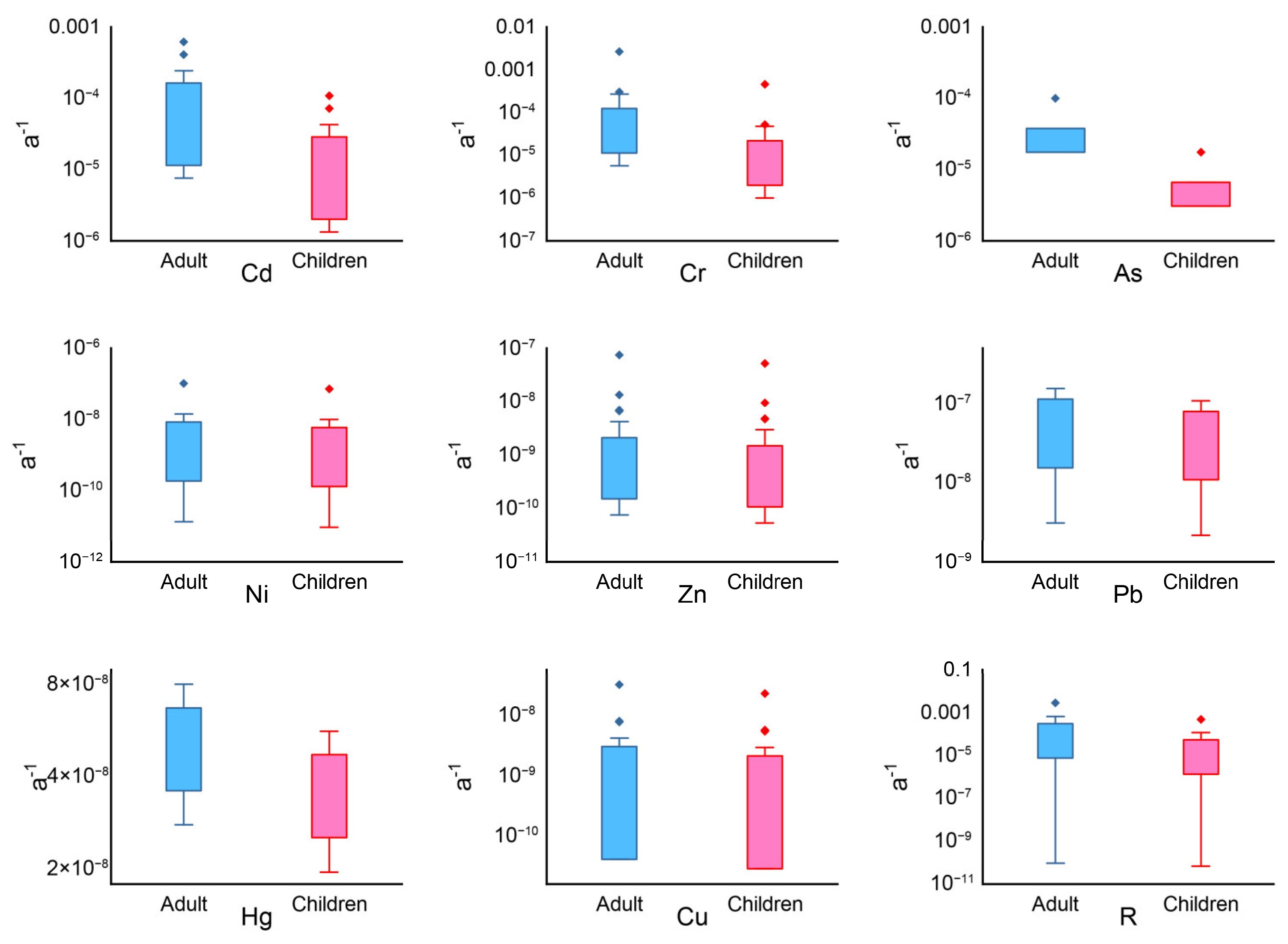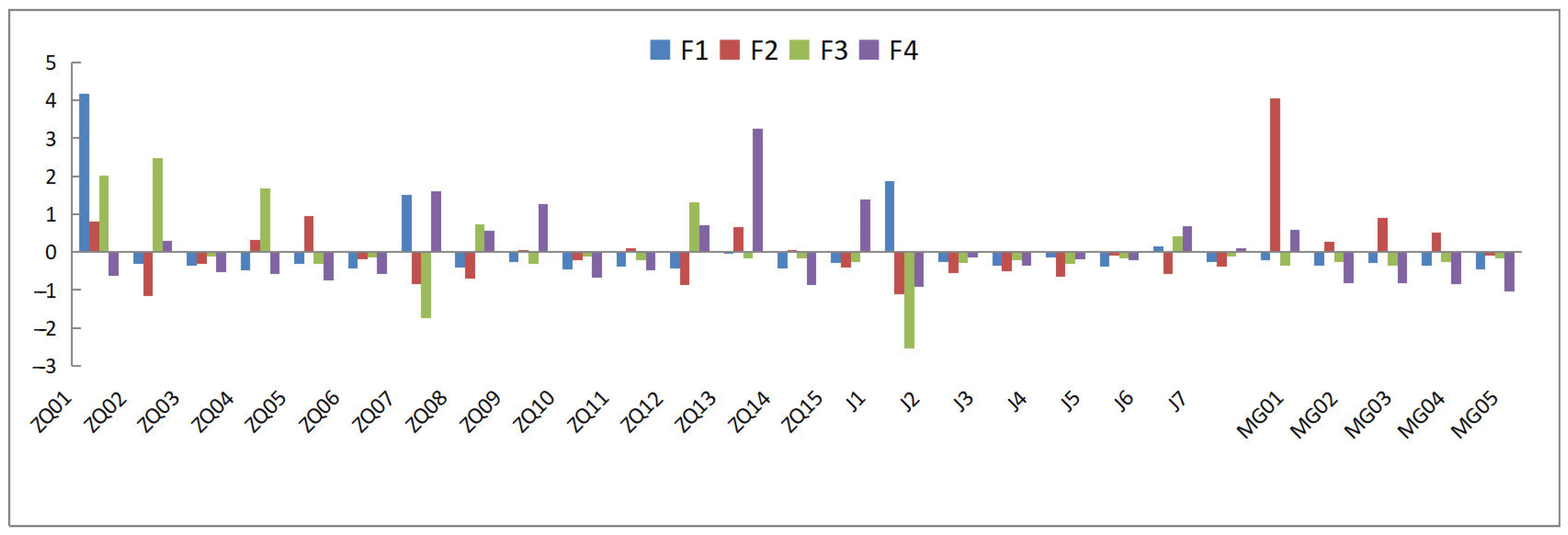Source Apportionment and Health Risk Assessment of Heavy Metals in Karst Water from Abandoned Mines in Zhangqiu, China
Abstract
:1. Introduction
2. Materials and Methods
2.1. Site Overview
2.2. Sample Collection and Determination
2.3. Data Statistics and Analysis
- (1)
- Conduct the KMO and Bartlett tests to determine the possibility of subjecting the data to PCA. The Kaiser–Meyer–Olkin (KMO) test statistic is an indicator used to compare simple correlation coefficients and partial correlation coefficients between variables.
- (2)
- Calculate the homogeneity and standard deviation of each index to obtain standardized data and eliminate the influence of variables based on the order of magnitude or dimension.
- (3)
- Calculate the covariance matrix to describe the relationship between the variables in the data set.
- (4)
- Calculate the eigenvalues and eigenvectors of the covariance matrix, and select the first k corresponding vectors with larger eigenvalues from the eigenvectors to form the principal components.
- (5)
- Calculate the principal component score, and analyze the significance represented by the principal component according to the coefficient.
2.4. Evaluation of Heavy Metal Pollution in Groundwater
2.5. Human Health Risk Assessment
2.5.1. Health Risk Assessment Model of Drinking Water Pathway
2.5.2. Health Risk Assessment Model of Dermal Contact Pathway
2.5.3. Total Health Risk Assessment of Water Body
3. Result and Discussion
3.1. Characteristics of Pollutant Concentration in Groundwater
3.2. Evaluation of Nemerow Comprehensive Pollution Index in Groundwater
3.3. Health Risk Assessment
3.4. Pollution Source Analysis
3.4.1. Analysis of Relationship
3.4.2. Principal Component Analysis
4. Conclusions
Author Contributions
Funding
Data Availability Statement
Acknowledgments
Conflicts of Interest
References
- Liu, Y.; Ma, R. Human health risk assessment of heavy metals in groundwater in the Luan River Catchment within the North China plain. Geofluids 2020, 2020, 8391793. [Google Scholar] [CrossRef]
- Wu, J.H.; Zhang, Y.X.; Zhou, H. Groundwater chemistry and groundwater quality index incorporating health risk weighting in Dingbian County, Ordos Basin of northwest China. Geochemistry 2020, 80, 125607. [Google Scholar] [CrossRef]
- Liu, Z.Q.; Qiu, F.G.; Li, H.Y.; Dong, H.; Fang, L.; Qiang, Z. Evaluations of rural drinking water quality and health risk in the North China Plain. Environ. Chem. 2021, 40, 2054–2063. (In Chinese) [Google Scholar]
- He, S.; Wu, J.H. Hydrogeochemical characteristics, groundwater quality, and health risks from hexavalent chromium and nitrate in groundwater of huanhe formation in Wuqi County, northwest China. Expo. Health 2019, 11, 125–137. [Google Scholar] [CrossRef]
- Shi, H.H.; Pan, Y.J.; Zeng, M.; Huang, C.S.; Hou, Q.Q.; Pi, P.C.; Peng, H.X. Source analysis and health risk assessment of heavy metals in groundwater of Leizhou peninsula. Environ. Sci. 2021, 42, 4246–4256. (In Chinese) [Google Scholar] [CrossRef]
- Khany, K.; Toqeer, M.; Shah, M.H. Spatial distribution, pollution characterization and health risk assessment of selected metals in groundwater of Lahore, Pakistan. Geochemistry 2021, 81, 125692. [Google Scholar] [CrossRef]
- Wang, L.; Tao, Y.; Su, B.; Wang, L.; Liu, P. Environmental and Health Risks Posed by Heavy Metal Contamination of Groundwater in the Sunan Coal Mine, China. Toxics 2022, 10, 390. [Google Scholar] [CrossRef]
- Kefeni, K.K.; Msagati, T.A.M.; Mamba, B.B. Acid mine drainage: Prevention, treatment options, and resource recovery: A review. J. Clean. Prod. 2017, 151, 475–493. [Google Scholar] [CrossRef]
- Rezaie, B.; Anderson, A. Sustainable resolutions for environ-mental threat of the acid mine drainage. Sci. Total Environ. 2020, 717, 137211. [Google Scholar] [CrossRef]
- Tomiyama, S.; Igarashi, T. The potential threat of mine drainage to groundwater resources. Curr. Opin. Environ. Sci. Health 2022, 27, 100347. [Google Scholar] [CrossRef]
- Feng, Q.Y.; Zhou, L. Risk Assessment and Control of Groundwater Pollution in Abandon Mine; China Environmental Science Press: Beijing, China, 2016. [Google Scholar]
- Chen, D.; Feng, Q.; Gong, M. Contamination Characteristics and Source Identification of Groundwater in Xishan Coal Mining Area of Taiyuan Based on Hydrochemistry and Sulfur–Oxygen Isotopes. Water 2023, 15, 1169. [Google Scholar] [CrossRef]
- Nkpaa, K.W.; Amadi, B.A.; Wegwu, M.O. Hazardous metals levels in groundwater from Gokana, Rivers State, Nigeria: Non-cancer and cancer health risk assessment. Hum. Ecol. Risk Assess. 2018, 24, 214–224. [Google Scholar] [CrossRef]
- Mirzabeygi, M.; Abbasnia, A.; Yunesian, M.; Nodehi, R.N.; Yousefi, N.; Hadi, M.; Mahvi, A.H. Heavy metal contamination and health risk assessment in drinking water of Sistan and Baluchistan, Southeastern Iran. Hum. Ecol. Risk Assess. 2017, 23, 1893–1905. [Google Scholar] [CrossRef]
- Naz, A.; Chowdhury, A.; Mishra, B.K.; Gupta, S.K. Metal pollution in water environment and the associated human health risk from drinking water: A case study of Sukinda chromite mine, India. Hum. Ecol. Risk Assess. 2016, 22, 1433–1455. [Google Scholar] [CrossRef]
- Tong, H.; Gao, Z.J.; Gao, F.S.; Liu, J.; Peng, Y.L.; Li, C. Hydrochemical characteristics and water quality evaluation of groundwater in the west of Yi River Basin. Environ. Chem. 2021, 40, 3443–3454. [Google Scholar]
- Xia, L.; You, H.C.; Liu, J.T.; Han, C.; Gao, Z.; Peng, Y.; Li, C. Hydrochemical Characteristics and Water Quality Evaluation of Groundwater in Coastal Area of Jiaodong Peninsula. Environ. Sci. Technol. 2021, 44, 1–10. [Google Scholar] [CrossRef]
- Han, C.; Gao, Z.J.; Liu, J.T.; Li, F.; Zhang, Y.; Liu, R.; Feng, C. Chemical Characteristics of Groundwater and Health Risk Assessment of Nitrate in Tancheng Area. Earth Environ. 2021, 49, 436–446. [Google Scholar] [CrossRef]
- Qiu, M.; Liu, L.; Zou, X.; Wu, L. Comparison of source water quality standards and evaluation methods between China and some developed countries. J. China Inst. Water Resour. Hydropower Res. 2013, 11, 176–182. [Google Scholar] [CrossRef]
- Cheng, J.X.; Cheng, S.G.; Zhang, W. Comparison and Analysis on Common Methods of Groundwater Quality Assessment. Saf. Environ. Eng. 2008, 15, 23–25. [Google Scholar]
- Shang, B.X.; Lü, Z.; Li, J.N.; Li, T.Q. Application of Fuzzy Mathematics and Single Factor lndex in Water Quality Evaluation. J. Hebei Univ. Environ. Eng. 2013, 23, 1–4. [Google Scholar]
- Li, C.P.; Li, G.X.; Luo, Y.M.; Li, Y.F. Fuzzy Mathematics-Based Groundwater Quality Evaluation of Six MSW Landfills in Beijing. Environ. Sci. 2008, 29, 2729–2735. [Google Scholar] [CrossRef]
- Huang, Y.Y.; Zeng, Y.; Liu, S.J.; Ma, Y.H.; Xu, X. Community Structure of Aquatic Community and Evaluation of Water Quality in Laoyingyan Section of Dadu River. Environ. Sci. 2016, 37, 132–140. [Google Scholar] [CrossRef]
- Yan, B.; Xiao, C.; Liu, H.; Wei, R.; Liang, X. Effect of urban land use on the spatial distribution of groundwater pollution in the Jilin City. China Environ. Sci. 2015, 35, 934–942. [Google Scholar]
- Zhang, X.Y.; Zhang, Y.X.; Ren, Z.Y.; Duan, Z.L. Comparison and practical example of assessment method in different groundwater qualities. J. Water Resour. Water Eng. 2014, 25, 98–101. [Google Scholar]
- Yu, C.C.; Zhao, W.T.; Gao, X.F.; Cheng, S.G.; Huang, T.; Yin, Y.M.; Zhao, Z.L. Distribution Characteristics and Health Risk Assessment of Heavy Metals in Surface Water Around Electroplating Factories. Environ. Sci. 2017, 38, 993–1001. [Google Scholar] [CrossRef]
- Yu, C.C.; Zhao, W.T.; Gao, X.F.; Cheng, S.G.; Xie, D.; Ma, P.T. Distribution Characteristics and Health Risk Assessment of Metals in Drinking Water Sources from the Luhun Reservoir. Environ. Sci. 2018, 39, 89–98. [Google Scholar] [CrossRef]
- Zhang, Y.; Li, F.; Ouyang, Z.; Zhao, G.; Li, J.; Liu, Q. Distribution and Health Risk Assessment of Heavy Metals of Groundwaters in the lrrigation District of the Lower Reaches of Yellow River. Environ. Sci. 2013, 34, 121–128. [Google Scholar] [CrossRef]
- Zhang, J.Q.; Tian, Q.; Xu, D.M.; Zhan, C.L.; Liu, T.; Yao, R.Z.; Liu, X.L.; Xiao, W.S. Pollution Characteristics and Risk Assessment of Heavy Metals in Water and Sediment from Daye Lake. Environ. Sci. 2017, 38, 2355–2363. [Google Scholar] [CrossRef]
- Zhang, Q.Q.; Pan, S.L.; Liu, W.; Zhang, Y.; An, W. Accumulated Health Risk Assessment of Arsenic in Drinking Water of Major Cities of China. Environ. Sci. 2017, 38, 1835–1841. [Google Scholar] [CrossRef]
- Zhou, J.M.; Jiang, Z.C.; Xu, G.L.; Qin, X.Q.; Huang, Q.B.; Zhang, L.K. Water Quality Analysis and Health Risk Assessment for Groundwater at Xiangshui, Chongzuo. Environ. Sci. 2019, 40, 2675–2685. [Google Scholar] [CrossRef]
- Li, Y.; Li, C.J. Analysis on the historical observation data from Zhangqiu national ordinary meteorological station. Hubei Agric. Sci. 2021, 60, 126–130. [Google Scholar] [CrossRef]
- Zhang, X.L.; Hu, Z.G.; Tian, L.M.; Zhang, Y.; Zhao, X.; Zhao, L. The Research on the Types and Distribution Regularities of lmportant Geoheritage in Jinan City. Sci. Technol. Vis. 2019, 16, 48–50+94. [Google Scholar] [CrossRef]
- Sun, M.Y.; Gao, Z.Y.; Wan, S.P.; Shao, Q.; Sun, Y. Analysis of hydrogeological conditions in the sevelopment and utilization of groundwaterground source heat pump system in Zhangqiu District. Environ. Dev. 2019, 31, 164–165. [Google Scholar] [CrossRef]
- Alberto, W.D.; del Pilar, D.M.; Valeria, A.M.; Fabiana, P.S.; Cecilia, H.A.; de Los Ángeles, B.M. Pattern Recognition Techniques for the Evaluation of Spatial and Temporal Variations in Water Quality. A Case Study: Suquía River Basin (Córdoba–Argentina). Water Res. 2001, 35, 2881–2894. [Google Scholar] [CrossRef]
- Zhou, S.J.; Sun, S.Q.; Wang, J.C.; Ni, X.; Chu, W. Comprehensive Evaluation of River Water Environmental Quality Based on the Principal Component Analysis. Environ. Sci. Manag. 2007, 32, 172–175. [Google Scholar]
- Liu, Z.T.; Li, C.M.; Zhang, G.Y. Application of Principal Component Analysis to the Distributions of Heavy Metals inthe Water of Lakes and Reservoirs in Yunnan Province. Res. Environ. Sci. 2010, 23, 459–466. [Google Scholar] [CrossRef]
- Feng, L.H. Principal Component Analysis of Environmental Quality. Math. Pract. Theory 2003, 33, 32–35. [Google Scholar]
- Fu, R.J.; Xin, C.L.; Yu, S.; Li, X. Analysis of Heavy Metal Sources in Groundwater and Assessment of Health Risks: An Example from the Southwest Sub-basin of the Shiqi River. Environ. Chem. 2023, 44, 796–806. [Google Scholar] [CrossRef]
- Zhou, J.M.; Jiang, Z.C.; Xu, G.L.; Qin, X.Q.; Huang, Q.B.; Zhang, L.K. Distribution and health risk assessment of metals in groundwater around iron mine. China Environ. Sci. 2019, 39, 1934–1944. [Google Scholar]
- Zhao, X.G.; Duan, X.L. Highlights of the Chinese Exposure Factors Handbook (Adults); China Environmental Science Press: Beijing, China, 2014. [Google Scholar]
- Duan, X.L. Highlights of the Chinese Exposure Factors Handbook (Children); China Environmental Science Press: Beijing, China, 2016. [Google Scholar]
- Li, J.; Miao, X.; Hao, Y.; Xie, Z.; Zou, S.; Zhou, C. Health risk assessment ofmetals (Cu, Pb, Zn, Cr, Cd, As, Hg, Se) in angling fish withdifferent lengths collected from Liuzhou, China. Int. J. Environ. Res. Public Health 2020, 17, 2192. [Google Scholar]
- Giri, S.; Singh, A.K. Risk assessment, statistical source identification and seasonal fluctuation of dissolved metals in the Subarnarekha River, India. J. Hazard. Matarials 2014, 265, 305–314. [Google Scholar] [CrossRef] [PubMed]
- Qiao, J.; Zhu, Y.; Jia, X.; Niu, X.; Liu, J. Distributions of arsenic andother heavy metals, and health risk assessments for groundwaterin the Guanzhong Plain region of China. Environ. Res. 2019, 181, 108957. [Google Scholar]








| Health Risk Assessment | PC 10−3 cm × h−1 | SF/(kg × d) × mg−1 | RFD/mg × (kg × d)−1 | AT/d | |||
|---|---|---|---|---|---|---|---|
| Drinking Water Pathway | Dermal Contact Pathway | Drinking Water Pathway | Dermal Contact Pathway | ||||
| Carcinogenic | As | 1.8 | 1.5 | 3.66 | 0.0003 | 0.000123 | 25,550 |
| Cr | 2 | 41 | 41 | 0.003 | 0.003 | ||
| Cd | 1 | 6.1 | 6.1 | 0.0005 | 0.0005 | ||
| Non carcinogenic | Ni | 0.1 | — | — | 0.02 | 0.0054 | ED × 365 |
| Zn | 0.6 | — | — | 0.3 | 0.01 | ||
| Pb | 0.4 | — | — | 0.00035 | 0.000053 | ||
| Hg | 1.8 | — | — | 0.0003 | 0.0003 | ||
| Cu | 0.6 | — | — | 0.04 | 0.012 | ||
| Parameter | Implication | Reference Value | Unit | Reference | |
|---|---|---|---|---|---|
| Adults | Children | ||||
| IR | Water intake | 2.2 | 1 | L × d−1 | [41,42] |
| EF | Exposure frequency | 365 | 365 | d × a−1 | [41,42] |
| BW | Weight per capita | 60 | 25 | kg | [41,42] |
| SA | Contact with the surface area of the skin | 18,000 | 8000 | cm2 | [41,42] |
| ET | Exposure time | 0.6333 | 0.4167 | h × d−1 | [41,42] |
| L | Human longevity | 70 | 70 | a | [43] |
| CF | volume Conversion factor | 1 | 1 | ml × cm−3 | [43] |
| ED | Exposure duration | 24 | 6 | a | [40,41] |
| Index | Detection Limit | Standard Limit | Min | Average | Max | Standard Deviation | Coefficient of Variation | Excess Rate (%) |
|---|---|---|---|---|---|---|---|---|
| pH | - | 6.5–8.5 | 3.10 | 6.54 | 7.7 | 1.19 | 0.18 | 22.22 |
| THS (mg × L−1) | 5 | 450 | 342.00 | 1235.19 | 2930 | 771.30 | 0.62 | 88.89 |
| TDS (mg × L−1) | 5 | 1000 | 513.00 | 4471.59 | 34400 | 8159 | 1.82 | 74.07 |
| COD (mg × L−1) | 0.5 | 3.0 | 0.95 | 70.9 | 504.6 | 153.04 | 2.48 | 59.26 |
| F (mg × L−1) | 0.05 | 1 | 0.1 | 1.02 | 14.6 | 2.79 | 2.74 | 11.11 |
| Cl (mg × L−1) | 10 | 250 | 5 | 38.48 | 318 | 57.74 | 1.50 | 3.70 |
| NO3−(mg × L−1) | 0.1 | 20 | 0.4 | 6.04 | 21.7 | 5.25 | 0.87 | 3.70 |
| SO42−(mg × L−1) | 0.025 | 250 | 4 | 332 | 2730 | 599.40 | 1.81 | 14.81 |
| Level of Pollutant | Wi | Level of Pollutant | Wn | |||||||
|---|---|---|---|---|---|---|---|---|---|---|
| Cu | Cr | Ni | Zn | Pb | Cd | Hg | As | |||
| Cleaning (Wi ≤ 1) | 26 | 24 | 10 | 22 | 18 | 24 | 22 | 22 | Pollution-free (Wn ≤ 0.7) | 10 |
| light pollution (1 < Wi ≤ 2) | 0 | 1 | 1 | 2 | 3 | 2 | 1 | 3 | low pollution (0.7 < Wn ≤ 1) | 1 |
| moderate pollution (2 < Wi ≤ 3) | 1 | 0 | 2 | 1 | 2 | 0 | 2 | 0 | moderate pollution (1 < Wn ≤ 2) | 0 |
| heavy pollution (Wi > 3) | 0 | 2 | 14 | 2 | 4 | 1 | 2 | 2 | heavy pollution (Wn > 2) | 16 |
| Item | Element | Drinking Water Pathway | Skin Infiltration Pathway | ||
|---|---|---|---|---|---|
| Adults | Children | Adults | Children | ||
| Carcinogenic | As | 1.46 × 10−6 | 3.97 × 10−7 | 1.36 × 10−5 | 2.38 × 10−6 |
| Cd | 2.62 × 10−5 | 7.16 × 10−6 | 2.72 × 10−4 | 4.77 × 10−5 | |
| Cr | 6.72 × 10−5 | 1.83 × 10−5 | 3.48 × 10−4 | 6.11 × 10−5 | |
| Noncarcinogenic | Ni | 3.14 × 10−8 | 3.42 × 10−8 | 1.63 × 10−8 | 1.14 × 10−8 |
| Zn | 2.43 × 10−9 | 2.65 × 10−9 | 7.56 × 10−9 | 5.31 × 10−9 | |
| Pb | 3.21 × 10−8 | 3.50 × 10−8 | 6.65 × 10−8 | 4.67 × 10−8 | |
| Hg | 9.51 × 10−10 | 1.04 × 10−9 | 8.87 × 10−9 | 6.22 × 10−9 | |
| Cu | 1.89 × 10−9 | 2.06 × 10−9 | 5.86 × 10−9 | 4.11 × 10−9 | |
| Total Health Risk | 9.51 × 10−5 | 2.59 × 10−5 | 6.34 × 10−4 | 1.11 × 10−4 | |
| Index | F1 | F2 | F3 | F4 |
|---|---|---|---|---|
| As | 0.899 | −0.108 | 0.088 | −0.155 |
| Cd | 0.856 | 0.142 | 0.401 | −0.009 |
| Cr | 0.930 | 0.025 | 0.168 | −0.186 |
| Cu | 0.833 | 0.105 | 0.412 | −0.002 |
| Hg | 0.115 | −0.196 | 0.810 | 0.035 |
| Ni | 0.918 | 0.054 | 0.248 | 0.062 |
| Pb | 0.833 | 0.088 | 0.500 | −0.092 |
| Zn | 0.863 | −0.032 | 0.070 | 0.182 |
| pH | −0.884 | 0.184 | 0.088 | −0.270 |
| Th | 0.231 | −0.317 | 0.146 | 0.793 |
| Cl− | −0.167 | 0.840 | −0.066 | 0.104 |
| COD | 0.907 | −0.154 | −0.223 | 0.041 |
| TDS | 0.934 | −0.082 | −0.016 | −0.052 |
| SO42− | −0.129 | 0.109 | −0.071 | 0.748 |
| NO3− | 0.148 | 0.861 | −0.102 | −0.218 |
Disclaimer/Publisher’s Note: The statements, opinions and data contained in all publications are solely those of the individual author(s) and contributor(s) and not of MDPI and/or the editor(s). MDPI and/or the editor(s) disclaim responsibility for any injury to people or property resulting from any ideas, methods, instructions or products referred to in the content. |
© 2023 by the authors. Licensee MDPI, Basel, Switzerland. This article is an open access article distributed under the terms and conditions of the Creative Commons Attribution (CC BY) license (https://creativecommons.org/licenses/by/4.0/).
Share and Cite
Han, Y.; Liu, Y.; Wei, S.; Wang, M.; Ding, G.; Song, X.; Shen, D.; Gao, S.; Tang, C.; Ma, G. Source Apportionment and Health Risk Assessment of Heavy Metals in Karst Water from Abandoned Mines in Zhangqiu, China. Water 2023, 15, 3440. https://doi.org/10.3390/w15193440
Han Y, Liu Y, Wei S, Wang M, Ding G, Song X, Shen D, Gao S, Tang C, Ma G. Source Apportionment and Health Risk Assessment of Heavy Metals in Karst Water from Abandoned Mines in Zhangqiu, China. Water. 2023; 15(19):3440. https://doi.org/10.3390/w15193440
Chicago/Turabian StyleHan, Yu, Yuxiang Liu, Shanming Wei, Min Wang, Guantao Ding, Xiaoyu Song, Dandan Shen, Shuai Gao, Cui Tang, and Guanqun Ma. 2023. "Source Apportionment and Health Risk Assessment of Heavy Metals in Karst Water from Abandoned Mines in Zhangqiu, China" Water 15, no. 19: 3440. https://doi.org/10.3390/w15193440
APA StyleHan, Y., Liu, Y., Wei, S., Wang, M., Ding, G., Song, X., Shen, D., Gao, S., Tang, C., & Ma, G. (2023). Source Apportionment and Health Risk Assessment of Heavy Metals in Karst Water from Abandoned Mines in Zhangqiu, China. Water, 15(19), 3440. https://doi.org/10.3390/w15193440





